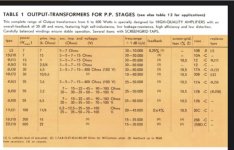Hi, I recently found in a garage sale a single channel very nice tube amplifier with 3xECC81 and 2xEL34; it had been used in the local church and still plays beautifully! It has an impressive output transformer, model 4U63 by Unitran which is a regrettably discontinued Dutch brand. See also attachment. It says Output impedances 0-3-5-7-15-400 ohms. My question is, are these figures cumulative? In other words, is the output impedance between “0” and “5” 5ohms or 8? What is the custom, does somebody know? I used “0” and “7” for an 8ohm speaker now but I was wondering if I should use “0” and “5” or maybe “7” and “15” (15-7=8).
Attachments
You should learn just a bit about transformers. Like ratios, impedance conversion.
Your question can be fully answered if you assume the secondary is a single piece of wire with multiple taps. Each tap corresponds to a winding ratio and one tap is common. There is no "custom", it is basic common sense.
Your question can be fully answered if you assume the secondary is a single piece of wire with multiple taps. Each tap corresponds to a winding ratio and one tap is common. There is no "custom", it is basic common sense.
The output voltages are cumulative, and impedance varies like the square of the voltage. Hence the '7' and '15' taps will together drive 1.5 ohms - but not too well if the secondary has varying copper thickness.
Impedances shown in your table are all between 0/common terminal and one of the other taps; the number indicating the recommended load impedance.output transformer, model 4U63 ..... It says Output impedances 0-3-5-7-15-400 ohms. My question is, are these figures cumulative? In other words, is the output impedance between “0” and “5” 5ohms or 8?
You use the closest one.
No "custom" involved but what the spec says, and yes, we know.What is the custom, does somebody know?
correct.I used “0” and “7” for an 8ohm speaker
no, that fits a 5 ohm speaker.now but I was wondering if I should use “0” and “5”
No, those impedance numbers do not apply any more if you do not use the common tap.or maybe “7” and “15” (15-7=8).
And to make it more clear to you: transformers, even Output ones, really have windings which put out defined voltage, but which translate to impedance values.
Sadly the translation is not linear.
Now you can add/substract voltage, no big deal, because there is a linear relation between them.
Say you have two 4V taps, adding them gives you 8V
Or you have 8V and 12V taps (always referred to 0/common), then you have 4 V between the 8V and the 12V ones.
There it does apply 12V-8V=4V
But you can not do same with impedance.
Feel curious about what will really happen?
You must first translate impedance back to voltage, add-substract as needed and then re-convert to impedance.
What DF96 did , by the way, he didn´t pull his answer out of the blue.
Last edited:
Remember if you change the load you are changing the reflected primary impedance seen by the valve so you are changing the bias designed by the manufacturer.
Don't over-think. The intended customers were not supposed to be math-heads.
0-3, 0-7, and 0-15 are correct connections for what we call 4, 8, and 16 Ohm speakers.
0-5 is a bonus. Suits a 6 Ohm nominal speaker (three 16 in parallel, or some box-sets now use 6 Ohm impedance). It appears probably because the winding is multiple interleaf (many sections of primary and secondary in layers) and there was a splice here which they brought out in case it would be useful.
The odd duck is the "400". The note says "100V". This is a common system for schools and factories with dozens of speakers. A transformer at each speaker takes nominal "100V" level and transforms it to 1,2,4, or 8 Watts nominal, so speakers loudness can be set without massive math. However 100V in 400r is nominal 25 Watts, not the 35W rating of the transformer. This is probably just conservative engineering, since in large systems "all" the loads may not be carefully accounted, and a little leeway means fewer complaints. You do NOT want that 400r tap for any home hi-fi.
0-3, 0-7, and 0-15 are correct connections for what we call 4, 8, and 16 Ohm speakers.
0-5 is a bonus. Suits a 6 Ohm nominal speaker (three 16 in parallel, or some box-sets now use 6 Ohm impedance). It appears probably because the winding is multiple interleaf (many sections of primary and secondary in layers) and there was a splice here which they brought out in case it would be useful.
The odd duck is the "400". The note says "100V". This is a common system for schools and factories with dozens of speakers. A transformer at each speaker takes nominal "100V" level and transforms it to 1,2,4, or 8 Watts nominal, so speakers loudness can be set without massive math. However 100V in 400r is nominal 25 Watts, not the 35W rating of the transformer. This is probably just conservative engineering, since in large systems "all" the loads may not be carefully accounted, and a little leeway means fewer complaints. You do NOT want that 400r tap for any home hi-fi.
- Home
- Amplifiers
- Tubes / Valves
- Are transformer impedance figures cumulative?

